The Japanese American artist, renowned for merging Eastern and Western influences, had once envisioned revitalizing one of Hawaiʻi’s most sacred sites—a dream project that ultimately was never realized.
Archival Images from Isamu Noguchi Foundation and Garden Museum
In 1976, American sculptor Isamu Noguchi met Hawaiʻi patron of the arts Paul Yamanaka and architect Gus Ishikawa at Pearl City Tavern. The 72-year-old Noguchi, already considered a master for his work in landscape architecture and abstract sculptures, had been introduced to Yamanaka by fellow artist Jean Charlot; the two men were brought together after Noguchi shared with Charlot, a French expatriate muralist who had been living on O‘ahu for over two decades, his desire to know “the real meaning of Hawai‘i.”
Noguchi’s modest request prompted Yamanaka to take him to Kūkaniloko, a monument of birthstones considered by Native Hawaiians to be the geographical and spiritual center of O‘ahu, with a sacred connection to other important sites across Hawai‘i and the Pacific. “It was held to be a most distinguished honor to be born at Kukanikoko,” noted a historian in 1903. “Queens in expectation of motherhood were accustomed to go to Kukaniloko in advance that by undergoing the pain of labor in that place they might confer on their offspring this inestimable boon.”
However, by the ’70s, the general public were unaware of its stately legacy. Kūkaniloko was just a quiet site among sprawling pineapple fields on the outskirts of the agricultural town of Wahiawa in central O‘ahu. At the time, the area’s priorities were dominated by the plantation industry and the money flowing from the nearby Schofield Barracks Army Installation.
Yet, even among the changes Wahiawa experienced, the need to perpetuate the birthstones’ significance continued for those who remembered Kūkaniloko’s legacy. Through the 1920s, during its territorial period of Hawai‘i characterized by cultural repression, the nonprofit organization Daughters of Hawai‘i, a hui of women who maintain two royal palaces, took great pains to protect Kūkaniloko also. While regular care for the site faded, it was not forgotten — in 1973, three years before Noguchi would lay his eyes on nā pōhaku, or the stones, Kūkaniloko was added to the U.S. National Register of Historic Places.
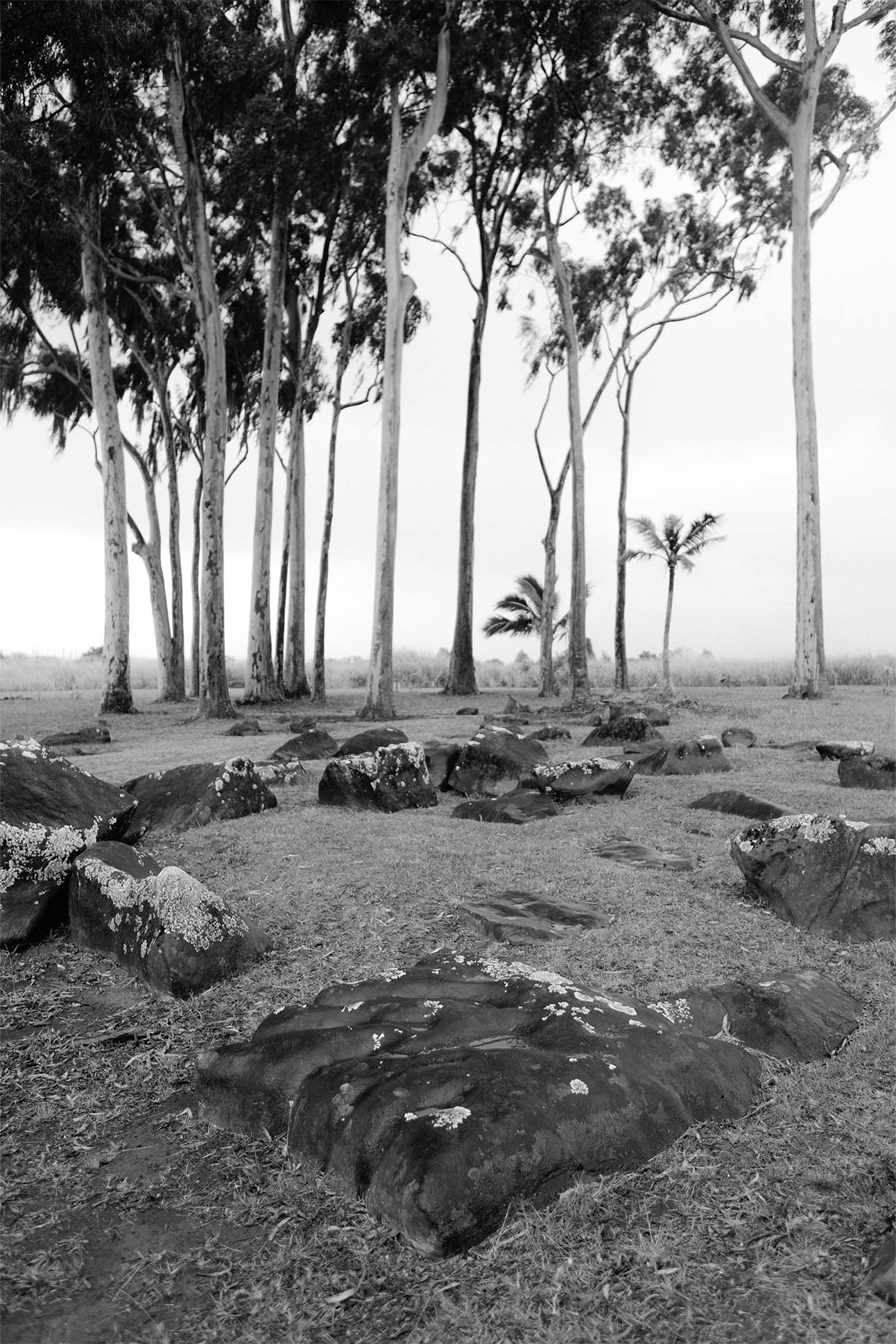
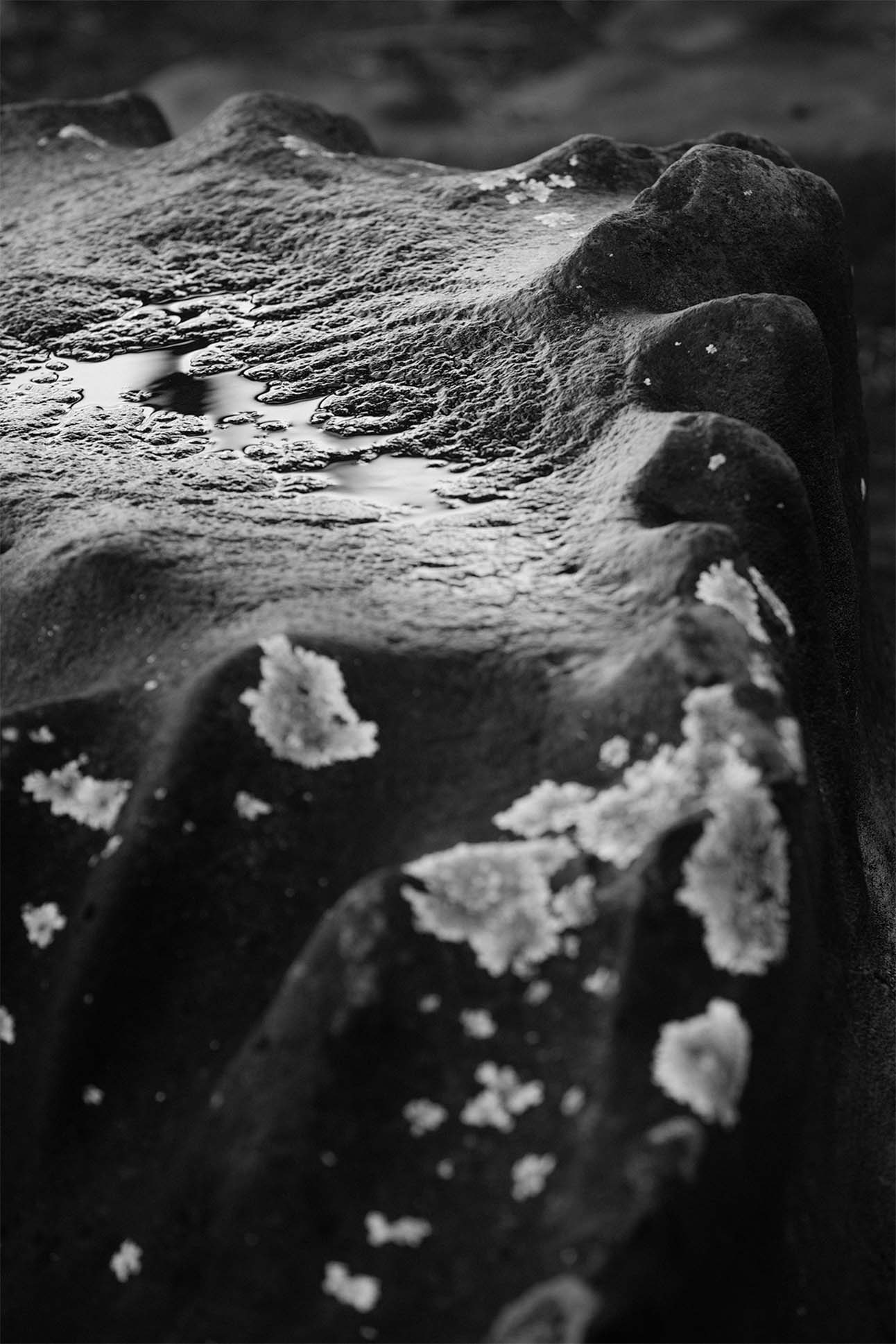
By 1975, members of the Wahiawa Hawaiian Civic Club, most notably Hiram Diamond, desired to revitalize the site to enhance its historical significance for Native Hawaiians and the rest of the island’s multiethnic population. Diamond convened a meeting on the topic at the Wahiawa Public Library with attendees from legislators like State Representative and Chair of the House Committee on Culture and the Arts Richard Ho and Hawaiian studies experts, including Charles W. Kenn, John Dominis Holt, and Abraham Pi‘ianai‘a. Among this fledgling restoration committee was Yamanaka, who in 1973 moved three boulders from an outcropping in a pineapple field near Kūkaniloko to Queen Kapi‘olani Rose Garden, a magisterial garden in Waikīkī he maintained as its curator. In the process of looking for stones to guard the garden, Yamanaka came to believe it wasn’t possible to move the site’s birthstones and embedded outcroppings themselves, as they had “too much mana.”
For his part, Noguchi was thoroughly impressed when he visited Kūkaniloko in 1976. “These stones I consider sacred and I believe are an important heirloom from Hawaii’s past,” he wrote in a letter to the editor of the Hawai‘i Observer in 1977. “Paul Yamanaka took me there and suggested that something should be done to save this important historical spot from the encroachment of the pineapples.”
The same year that Noguchi visited the site, The Advertiser columnist Sammy Amalu called for the restoration of Kūkaniloko, writing that Yamanaka told him Noguchi “praised the contours and forms of the rocks and said they were every bit as wonderful as anything ever carved by the hand of man.” To a figure like Amalu, who was a proponent for Kūkaniloko’s protection, the words were gratifying at a time when the stones were “forgotten by the Hawaiian themselves.” Amalu imagined a plan “established not as a tourist attraction but rather as a shrine to the native people of Hawaii — and to the ancient Alii who were born there.”
Kukaniloko! For gods’ sake, let’s do something rational and realistic about it. It is a great treasure of Hawaii—neglected, ignored, desecrated.
John Dominis Holt, 1981
Might Noguchi, the great mid-century sculptor, be the one to use his artistry to revive its legacy, giving Kukaniloko the recognition it has long been owed?
With ties to both the United States and Japan, Noguchi saw Hawai‘i as a meeting place between the East and the West. Born on November 17, 1904 in California and raised in Japan, Noguchi would go on to become one of the 20th century’s most innovative and prolific artists, seamlessly moving between a range of disciplines. He was well known for his distinctive Akari lamps, Japanese paper lanterns imbued with a modernist sensibility that displayed his evolving belief in marrying art with function, as well as his large-scale art installations like California Scenario in Costa Mesa and Sunken Garden at Fosun Plaza in New York City, both of which nimbly incorporate monumental rocks into its landscape design and are still publicly accessible. Through much of his career, Noguchi frequently stopped in Hawai‘i while travelling between Japan and the United States.
As an artist, Noguchi first stayed in Hawai‘i in 1940 on a commission with the Hawaiian Pineapple Company, which resulted in the production of a wooden sculpture titled Spear Fisherman. Noguchi returned in 1976 for two public art commissions of which one was completed: the public sculpture for the City and County of Honolulu, known as Sky Gate, which still stands at Honolulu’s Civic Center. Completed in 1977, the pair of towering abstract steel arches cast shifting shadows throughout the day. Sky Gate, wrote biographer Dore Ashton, emerged as “another way of addressing the issue of cosmos, and one that has the local intonation of a place Noguchi saw as halfway between his two traditions.”
But the Hawai‘i project that seemed to most captivate — and ultimately elude — Noguchi was to build a fortress for the stones of Kūkaniloko. He conceptualized an enclosure of grass berms with undulating heights that would isolate whoever went into the enclosure from any consciousness of the pineapple fields or cars parked in the nearby lot, bringing full focus on the stones. No substantial funds would be required, Noguchi claimed, saying that “only the good will and willingness of people plus the use of bulldozers which I understand the pineapple people could easily supply themselves in the off season.” According to Ashton, Noguchi “pressed the project upon anyone he thought could bring it to fruition.”
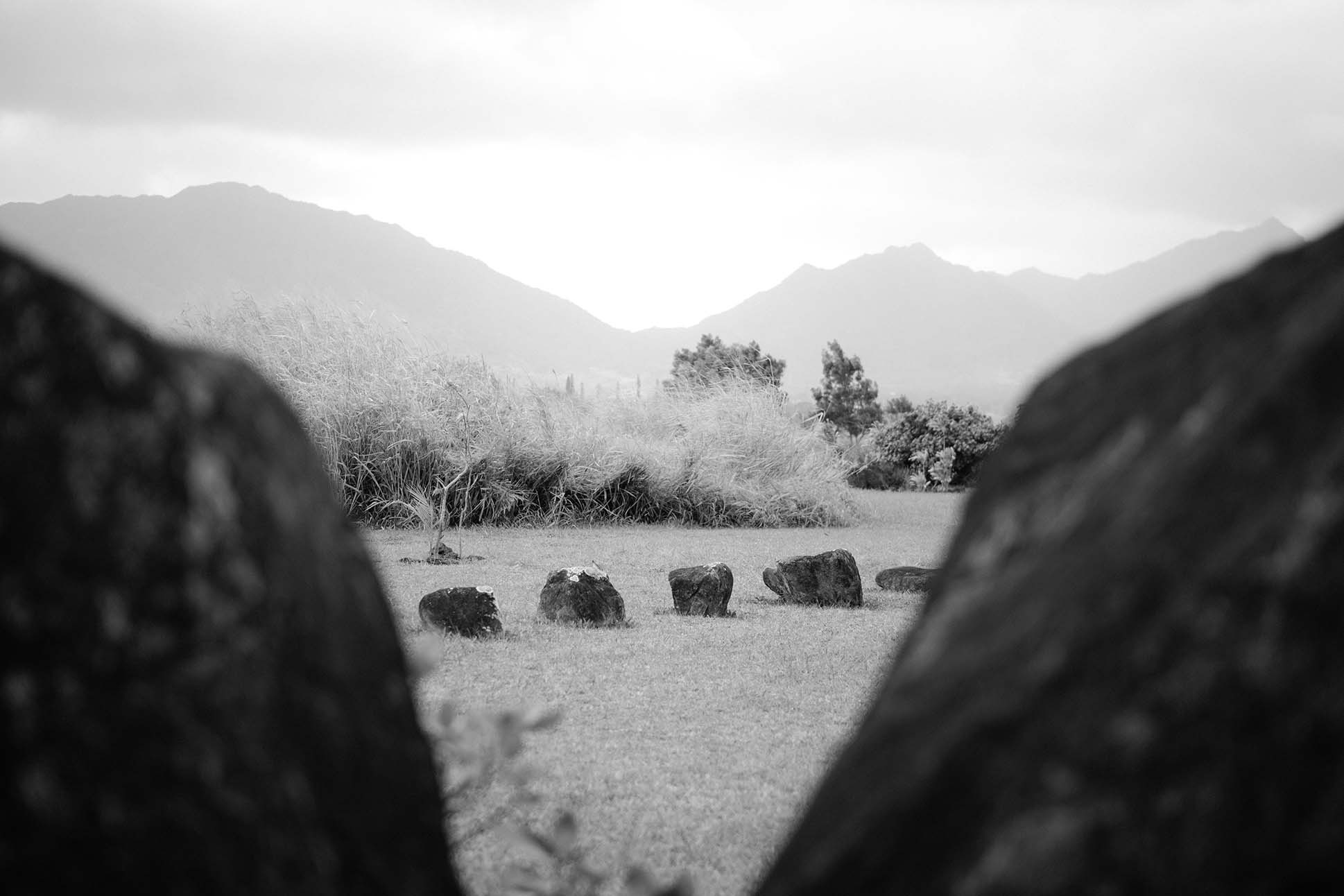
All he needed was political support to realize his vision. And in the 1980s, Noguchi’s designs found new supporters in David Hagino and Gerald Hagino, two Hawai‘i-born brothers who were also state legislators. David, in particular, had a long-standing fascination with Hawai‘i’s art scene, acquainted with artists like Hilo sculptor Sean Browne, a Native Hawaiian protégé of Noguchi’s. The Haginos also had a personal connection to Kūkaniloko, having grown up in Central O‘ahu, and advocated for the purchase of the site. David, whose career in politics was framed by the political movement Palaka Power, a philosophy that aspired to make Hawai‘i a model of progressive labor relations and empower the working class, wanted to help achieve Noguchi’s vision while implementing reparative justice for the long-marginalized Native Hawaiian community. More than any figure besides Noguchi, he played a major role in guiding the project.
At the same time, the now-octogenarian Noguchi was in failing health. Browne was the only one who carried a critical understanding of Noguchi’s vision for the site, and moves were made to begin establishing Browne as the natural successor to implement Noguchi’s vision. “I do believe that Sean will be excellent as intermediary for effectuating something good,” Noguchi wrote David on June 15, 1987. Noguchi met with Browne a final time after Thanksgiving 1988. Within a month, Noguchi was dead.
In 1989, William M. Paty, director of the Department of Land and Natural Resources, reported that the State of Hawai‘i had made an offer to the Hawaiian Trust Company for land including Kūkaniloko, but negotiations were slow. As a result, DLNR considered using eminent domain, and David soon urged the State to acquire 15 acres surrounding the site. In January 1990, DLNR informed the Hagino brothers that they could obtain five acres, with the Del Monte Corporation opposing the acquisition of any more land. The next month, DLNR seized five acres through condemnation to “protect the integrity of the birthstone site” and build a monument with a parking area. The Hawaiian Trust Company countered, offering a smaller disruption to Del Monte’s fields, and by July 1991, the State had acquired a five-acre site for Kūkaniloko.
While the State finalized proceedings to acquire the land, David turned to Isamu Noguchi Foundation’s executive director Shoji Sadao with the good news. “It has taken some time but the State is finally about to acquire the Kūkaniloko site,” he wrote.
David himself had a bright plan for the site’s future. If he could obtain a letter of support from the Noguchi Foundation for Noguchi’s original proposal, he wrote, he could get a similar letter of support from other entities such as the Wahiawa Hawaiian Civic Club. The Civic Club was particularly important, noted Hagino, because “the birth stones are in Wahiawa and the Club has served as official caretakers for the site.” In the meantime, David would work to secure the necessary funds for construction. By December, Sadao reported that the Foundation’s Board of Directors unanimously approved Noguchi’s design as a gift to the State of Hawai‘i.
These stones I consider sacred and I believe are an important heirloom from Hawaii’s past.
Isamu Noguchi, 1977
By February 1992, the deed of transfer was in Hagino’s possession. Both the Office of Hawaiian Affairs and the Board of Land and Natural Resources voted in favor of Noguchi’s design over the following year. When OHA offered their support in 1993, the agency noted that the site, through Noguchi’s vision, was to stay a wahi kapu, or sacred space, and that the person overseeing the execution of Noguchi’s design, furthermore, needed to be a Native Hawaiian. David was enthused. “At long last,” he wrote, “the State has finally adopted Isamu Noguchi’s design for the Kūkaniloko Birthstones.”
Then, soon after, an unexpected setback: DLNR director Keith Ahue pumped the brakes. He was concerned about the lack of resources, which he shared with David. There was likely not enough land. There was not enough funding. There was no consensus. Noguchi’s dream for Kūkaniloko risked being shelved once again.
More than a decade passed with Noguchi’s aspirations for Kūkaniloko in limbo. By 1994, the Haginos were no longer in the legislature, meaning the project lost its two primary backers. Meanwhile, an emerging generation of leadership at the Wahiawā Hawaiian Civic Club, which did not appear as enamored with Noguchi’s design, were generating new and necessary conversations about the historical significance of Kūkaniloko. A resolution to support Noguchi’s design also failed at the 1997 Association of Hawaiian Civic Clubs Convention in San Diego, California. Such conversations invited reflection on Noguchi’s 1970s vision. Did such a concept, after all, align with Native Hawaiian cosmology?
Funding for Kūkaniloko’s formation also never came. With no staff available to steward the site, the State Parks Division reached a curatorship agreement with the Wahiawā Hawaiian Civic Club and the Friends of Kūkaniloko in 1997, and Native Hawaiian residents of the community like Tom Lenchanko took on foundational roles in the site’s protection. “Most important is we’re trying to preserve [the stones] for the future,” Lenchanko explained to the Star Bulletin in October 1998. “To make everybody aware what is here in Wahiawa, and how sacred this place is.”
In 1999, the Hawai‘i State Legislature passed a resolution to request a feasibility study for the creation of a cultural tourism site. A community meeting held on November 3, 1999 at the Wahiawa Public Library — attended by members of the community’s Hawaiian Civic Club and the Friends of Kūkaniloko alongside members of the Whitmore Village Association, the DLNR, the Rotary club, a State Representative, and Gerald Hagino, now employed by Del Monte — made it clear that no tangible support for Noguchi’s proposal would be forthcoming. Some raised issues about how Noguchi’s proposition of a raised earthen berm could create visitation, security, and maintenance issues, while others, armed with burgeoning knowledge about the site’s ancient astronomical practices, worried about the effects the design would have on significant view corridors. The general consensus was that the design had artistic merit and was well-intentioned but also constituted a form of erasure. According to a report submitted by DLNR to the State legislature, the ultimate evaluation was that it “was not culturally appropriate to impose an art form on a cultural site that has its own history, form, and unique relationship to the landscape.” To the dissenters, Kūkaniloko was already in and of itself a work of art.
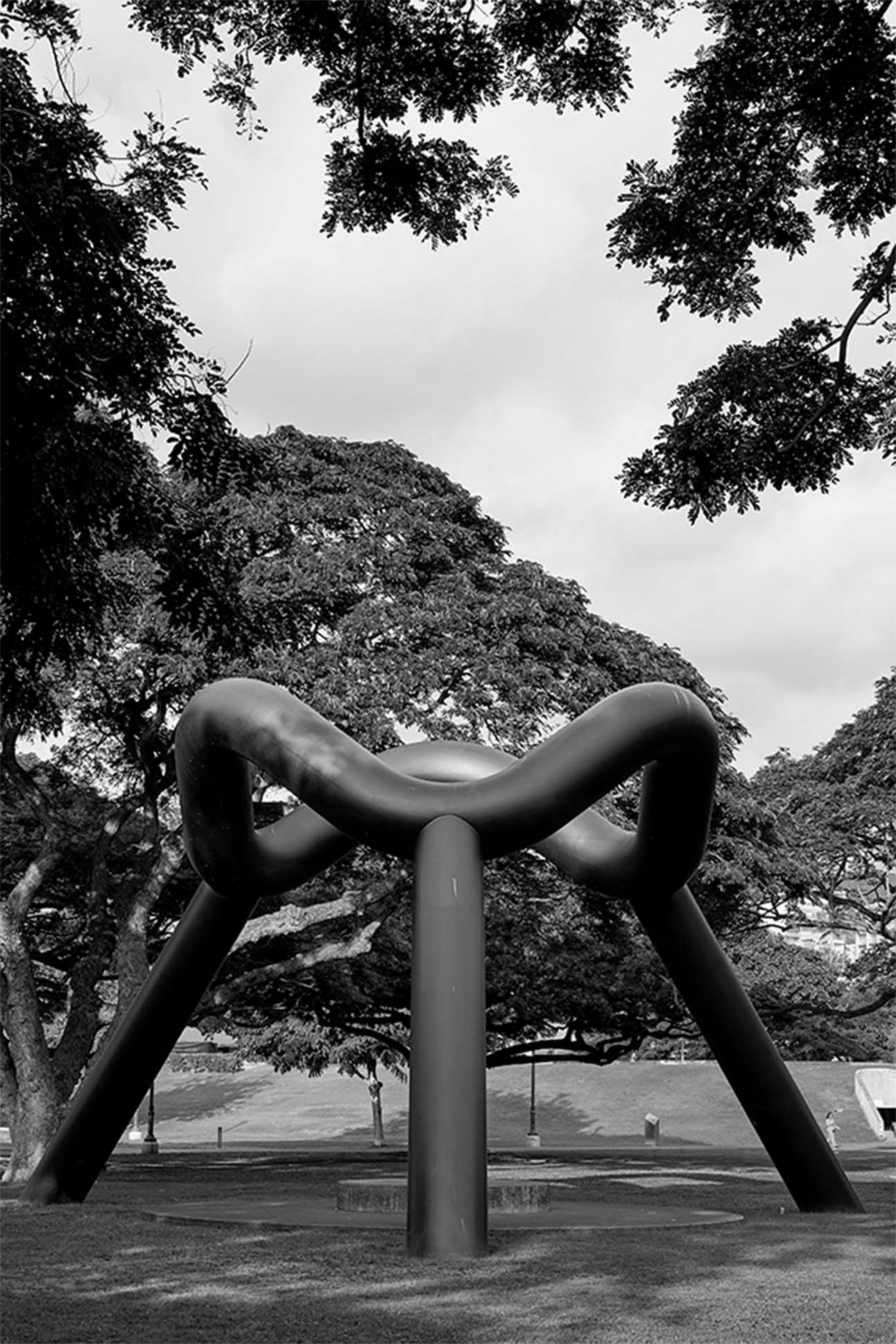
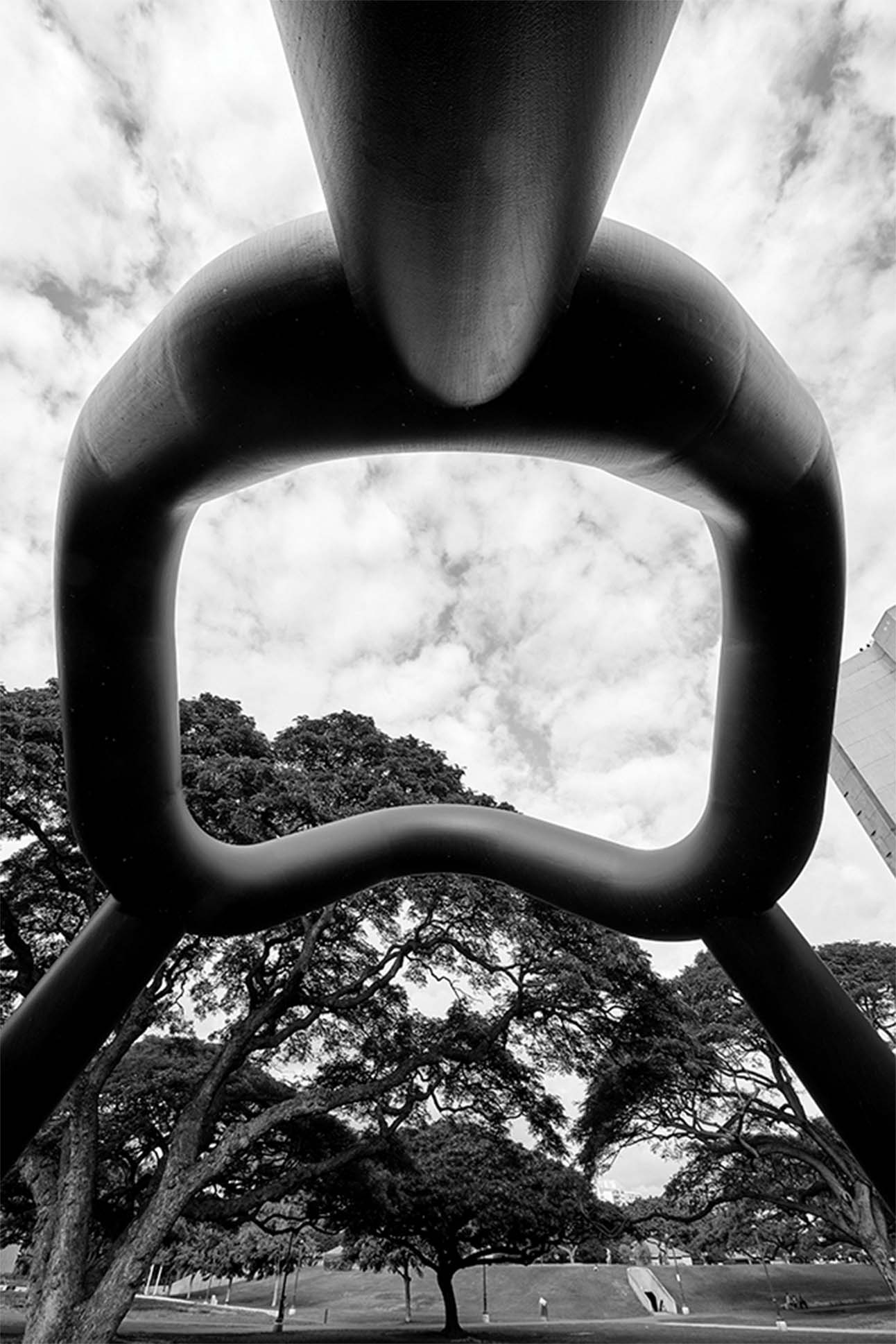
As the pineapple industry declined with the ceasing of Del Monte’s operations in the late 2000s, the State acquired more and more fallow agricultural lands. In 2018, OHA drafted a conceptual master plan for more than 500 acres of land under its stewardship surrounding Kūkaniloko. The plan, revised in 2021, made no mention of Noguchi’s design.
Noguchi’s passionate efforts, however, did help spark and maintain attention on the site when it was vulnerable. But, ironically enough, by not implementing his plan, the deeper significance of the place was preserved and discovered anew. As more Hawaiian knowledge and stewardship is supported around the birthstones, people are gaining a great appreciation of Kūkaniloko’s significance to O‘ahu.
Meanwhile, following centuries of deforestation due to plantation agriculture and colonization, the community has started a reforestation campaign on the surrounding acreage. Where Noguchi was trying to preserve a past encroached on by pineapple fields, it is the pineapple that has faded since his death in 1988.
“I allowed myself to become involved in designing an earth mound for the sacred birth rocks of Kūkaniloko upon the instigation of Paul Yamanaka,” Noguchi wrote fondly in 1977, “and as my homage to the original people of Hawaii, some of whose descendants I had the pleasure of meeting. This was my way to make restitution for my disturbance that I might have caused to the spirits of Hawaii with the other work.”
Today, Noguchi is also gone, but Kūkaniloko remains.

